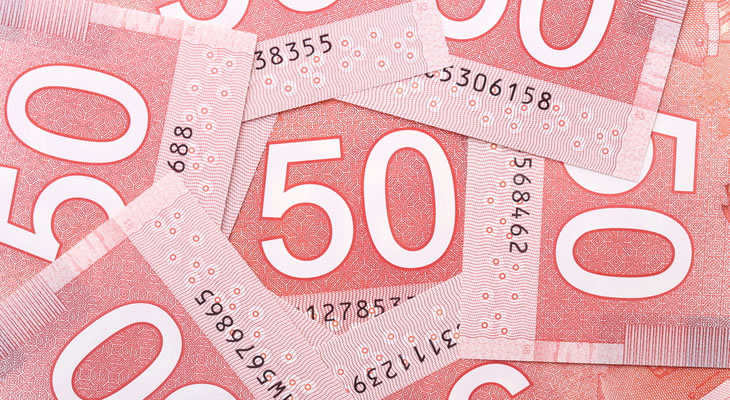- Poor UK PMIs softened Pound – Brexit-based uncertainty shown to have weakened domestic economy
- Canadian Dollar boosted by steady domestic inflation – BOC expected to maintain neutral outlook in response to robust data
- Sharp drop in UK business optimism failed to dent Sterling uptrend – GBP CAD exchange rate extended gains on oil price weakness
- Volatility expected on second quarter UK GDP result – Pound could rally on signs of economic robustness despite post-Brexit downturn
Bearish domestic data has failed to prevent the GBP CAD exchange rate returning to stronger form at the start of the week, with the ‘Loonie’ weighed down by increasing bets of an imminent Fed rate hike.
Canadian Dollar (CAD) Boosted by Steady Domestic Inflation
The Pound (GBP) slumped sharply in response to the first major post-Brexit economic data from the UK, as activity was shown to have slowed sharply in response to the vote. Markets were not encouraged to see that the Manufacturing, Services and Composite PMIs had all weakened substantially as a result of Brexit-based uncertainty. Especially worrying was the softening of growth in the service sector, which accounts for the largest portion of the UK economy and dropped from 52.3 to 47.4. This bearish data naturally undermined confidence in Sterling, prompting the Pound to Canadian Dollar (GBP CAD) exchange rate to trend markedly lower ahead of the weekend.
Demand for the ‘Loonie’ (CAD) picked up in response to signs of strength in the Canadian economy, meanwhile. Retail Sales were found to have weakened less than anticipated in May, while the June Consumer Price Index held steady on the year at 2.1%. This helped to boost the Canadian Dollar, seeming to increase the likelihood of the Bank of Canada (BOC) maintaining a neutral bias on monetary policy for the near future. However, the GBP CAD exchange rate received a boost towards the close of Friday’s European session, thanks to Brent crude extending its losses in the wake of another rise in the US rig count.
Large Drop in Business Optimism Failed to Prevent GBP CAD Exchange Rate Gains
Some measure of confidence returned to the Pound at the start of the week, with a round of consolidation trading helping to shore up the weakened currency. However, Sterling struggled to maintain its upward momentum in the wake of the latest CBI survey of business sentiment. While the Industrial Trends Orders figure ultimately bettered forecast, to clock in at -4 rather than -6, the general tone of the survey was rather bearish. Of particular note was the severe slump in business optimism, which plunged from -5 to -47 in the wake of the referendum. As CBI Chief Economist Rain Newton-Smith noted:
‘It’s clear that a cloud of uncertainty is hovering over industry, post-Brexit. We see this in weak expectations for new orders, a sharp fall in optimism and a scaling back of investment plans.’
The commodity-correlated ‘Loonie’ continued to weaken on Monday, with the price of oil sliding further below the US$45 per barrel mark. Worries over the persistent nature of the global supply glut have been weighing more heavily on the minds of investors in recent days, particularly as the US Dollar (USD) has strengthened. The rising odds that the Federal Reserve will opt to raise interest rates before the end of the year have kept markets wary of buying back into the higher-risk Canadian Dollar, particularly with no fresh domestic data to encourage confidence.
GBP CAD Exchange Rate Forecast: Stronger UK GDP Predicted to Bolster Pound
Wednesday’s second quarter UK GDP report is expected to provoke greater volatility for the Pound, despite the fact that the measure is indicative only of the pre-Brexit economy. Investors anticipate a modest uptick from 2.0% to 2.1% on the year, a result which could offer Sterling another rallying point. However, the impact of the result could be somewhat muted, as Ross Walker, Research Analyst at RBS, noted:
‘There has been a growing divergence in recent months between deteriorating surveys and more resilient official output statistics. The trends in the surveys are likely to be more indicative of future conditions, as Brexit-related risks materialise – initially through postponed capex and hiring, subsequently through weaker consumer demand as labour market conditions deteriorate and wage inflation is squeezed further.’
Ahead of Friday’s Canadian GDP data the ‘Loonie’ will remain primarily under the influence of wider market sentiment. Developments in the US Dollar, and consequently risk appetite, will be of particular note. While the Federal Open Market Committee (FOMC) is not expected to make any change to policy at its July meeting any indications on future monetary policy are likely to trigger some pronounced market volatility. If the Fed proves more dovish on the subject of an interest rate hike, though, the GBP CAD exchange rate may well be pushed lower.
Current GBP, CAD Exchange Rates
At the time of writing, the Pound to Canadian Dollar (GBP CAD) exchange rate was trending higher in the region of 1.7595, while the Canadian Dollar to Pound (CAD GBP) pairing was slumped around 0.5756.


Comments are closed.